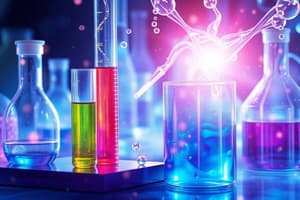Podcast
Questions and Answers
What is the primary function of Gas Chromatography (GC) and High-Performance Liquid Chromatography (HPLC)?
What is the primary function of Gas Chromatography (GC) and High-Performance Liquid Chromatography (HPLC)?
- To separate and identify proteins based on their size.
- To evaluate the concentration of allergens in samples.
- To measure biochemical markers in tissues.
- To separate and identify compounds in blood or urine. (correct)
Which method is specifically used to separate proteins based on their charge and size?
Which method is specifically used to separate proteins based on their charge and size?
- Electrophoresis (correct)
- Automated Analyzers
- High-Performance Liquid Chromatography
- Gas Chromatography
What is one of the key benefits of using automated analyzers in modern laboratories?
What is one of the key benefits of using automated analyzers in modern laboratories?
- They reduce the need for safety protocols.
- They eliminate all biochemical hazards.
- They enable high-throughput and rapid diagnostics. (correct)
- They are primarily used for DNA analysis.
What is an essential safety practice regarding chemical hazards in the laboratory?
What is an essential safety practice regarding chemical hazards in the laboratory?
Which of the following is a recommended action in the event of a chemical exposure?
Which of the following is a recommended action in the event of a chemical exposure?
What is the primary purpose of Gram Staining in diagnosing bacterial infections?
What is the primary purpose of Gram Staining in diagnosing bacterial infections?
Which technique is especially useful for detecting Mycobacterium species?
Which technique is especially useful for detecting Mycobacterium species?
What does a coagulase-positive result indicate in biochemical testing?
What does a coagulase-positive result indicate in biochemical testing?
In culture methods, what is the role of MacConkey agar?
In culture methods, what is the role of MacConkey agar?
What is a major advantage of using PCR in bacterial identification?
What is a major advantage of using PCR in bacterial identification?
Which of the following is not a culture method used for bacterial diagnosis?
Which of the following is not a culture method used for bacterial diagnosis?
What is indicated by turbidity in broth cultures?
What is indicated by turbidity in broth cultures?
What type of techniques can automated systems like VITEK and BD Phoenix perform?
What type of techniques can automated systems like VITEK and BD Phoenix perform?
What is the primary function of automated hematology analyzers?
What is the primary function of automated hematology analyzers?
Which test is primarily used to evaluate blood coagulation function?
Which test is primarily used to evaluate blood coagulation function?
What is the significance of low hemoglobin levels?
What is the significance of low hemoglobin levels?
Why is flow cytometry useful in hematologic analysis?
Why is flow cytometry useful in hematologic analysis?
Which of the following is a method commonly used to measure electrolytes in blood?
Which of the following is a method commonly used to measure electrolytes in blood?
What are ELISA tests primarily used for?
What are ELISA tests primarily used for?
What type of analysis provides insights into blood cell production?
What type of analysis provides insights into blood cell production?
Which of the following can indicate the presence of diseases when analyzing blood components?
Which of the following can indicate the presence of diseases when analyzing blood components?
Which physical sterilization method involves the use of pressurized steam?
Which physical sterilization method involves the use of pressurized steam?
What is the typical temperature range for dry heat sterilization?
What is the typical temperature range for dry heat sterilization?
Which sterilization method is best suited for heat-sensitive liquids?
Which sterilization method is best suited for heat-sensitive liquids?
Which method uses UV-C light for sterilization?
Which method uses UV-C light for sterilization?
What is a primary limitation of boiling as a sterilization method?
What is a primary limitation of boiling as a sterilization method?
Which sterilization technique can effectively penetrate deeply into materials?
Which sterilization technique can effectively penetrate deeply into materials?
What is the approximate boiling point of water used in sterilization?
What is the approximate boiling point of water used in sterilization?
Which physical sterilization method effectively kills microorganisms by burning them?
Which physical sterilization method effectively kills microorganisms by burning them?
What is sterilization primarily concerned with eliminating?
What is sterilization primarily concerned with eliminating?
Which statement describes a disinfectant?
Which statement describes a disinfectant?
What is a key difference between antiseptics and disinfectants?
What is a key difference between antiseptics and disinfectants?
Which of the following is a high-level disinfectant?
Which of the following is a high-level disinfectant?
What does chemical vapor sterilization require?
What does chemical vapor sterilization require?
Fumigation in chemical sterilization involves mixing potassium permanganate with which substance?
Fumigation in chemical sterilization involves mixing potassium permanganate with which substance?
At what temperature and pressure does the Chemiclave process operate?
At what temperature and pressure does the Chemiclave process operate?
Which category of disinfectants is effective against a few number of spores and vegetative bacteria?
Which category of disinfectants is effective against a few number of spores and vegetative bacteria?
Flashcards
Sterilization
Sterilization
The complete elimination of all living microorganisms, including spores.
Disinfectant
Disinfectant
Chemical agents used on non-living surfaces to kill or inactivate most harmful microorganisms.
Antiseptic
Antiseptic
Antimicrobial substances applied to living tissue or skin to reduce the risk of infection.
Steam Sterilization
Steam Sterilization
Signup and view all the flashcards
Chemical Sterilization
Chemical Sterilization
Signup and view all the flashcards
Chemical Liquid Sterilization
Chemical Liquid Sterilization
Signup and view all the flashcards
Chemical Vapor Sterilization
Chemical Vapor Sterilization
Signup and view all the flashcards
Fumigation
Fumigation
Signup and view all the flashcards
Autoclaving (Moist Heat Sterilization)
Autoclaving (Moist Heat Sterilization)
Signup and view all the flashcards
Dry Heat Sterilization
Dry Heat Sterilization
Signup and view all the flashcards
Filtration
Filtration
Signup and view all the flashcards
Radiation (Ionizing Radiation)
Radiation (Ionizing Radiation)
Signup and view all the flashcards
Ultraviolet (UV) Radiation
Ultraviolet (UV) Radiation
Signup and view all the flashcards
Boiling
Boiling
Signup and view all the flashcards
Incineration
Incineration
Signup and view all the flashcards
Formalin and Potassium Permanganate Sterilization
Formalin and Potassium Permanganate Sterilization
Signup and view all the flashcards
Gram Staining
Gram Staining
Signup and view all the flashcards
Acid-Fast Staining
Acid-Fast Staining
Signup and view all the flashcards
Broth Cultures
Broth Cultures
Signup and view all the flashcards
Coagulase Test
Coagulase Test
Signup and view all the flashcards
Oxidase and Urease Tests
Oxidase and Urease Tests
Signup and view all the flashcards
Automated Systems
Automated Systems
Signup and view all the flashcards
Polymerase Chain Reaction (PCR)
Polymerase Chain Reaction (PCR)
Signup and view all the flashcards
DNA Sequencing
DNA Sequencing
Signup and view all the flashcards
Chromatography
Chromatography
Signup and view all the flashcards
Gas Chromatography (GC)
Gas Chromatography (GC)
Signup and view all the flashcards
High-Performance Liquid Chromatography (HPLC)
High-Performance Liquid Chromatography (HPLC)
Signup and view all the flashcards
Electrophoresis
Electrophoresis
Signup and view all the flashcards
Automated Analyzers
Automated Analyzers
Signup and view all the flashcards
Automated Hematology Analyzers
Automated Hematology Analyzers
Signup and view all the flashcards
Blood Smear Microscopy
Blood Smear Microscopy
Signup and view all the flashcards
Hemoglobin and Hematocrit Tests
Hemoglobin and Hematocrit Tests
Signup and view all the flashcards
Prothrombin Time (PT) and Partial Thromboplastin Time (PTT)
Prothrombin Time (PT) and Partial Thromboplastin Time (PTT)
Signup and view all the flashcards
Platelet Function Tests
Platelet Function Tests
Signup and view all the flashcards
Flow Cytometry
Flow Cytometry
Signup and view all the flashcards
Bone Marrow Analysis
Bone Marrow Analysis
Signup and view all the flashcards
Clinical Chemistry
Clinical Chemistry
Signup and view all the flashcards
Study Notes
Sterilization, Disinfectants, and Antiseptics
- Sterilization is the killing of all living microbes, including spores.
- Disinfectants are antimicrobial agents applied to non-living objects to reduce pathogenic microorganisms.
- Antiseptics are antimicrobial substances applied to living tissue to reduce infection risk. Antiseptics must not harm living tissue.
- Not all disinfectants are antiseptics.
Sterilization Methods
- Sterilization methods are categorized into chemical and physical methods.
Chemical Sterilization
- Chemical sterilization is used for tools and devices sensitive to high heat or irradiation (e.g., plastics and rubber).
- Chemical liquid sterilization methods: includes solutions/liquids for sterilization.
- Chemical vapor sterilization methods: utilize vapor.
Disinfectant Classification
- High-level disinfectants: effective against a large number of spores after long exposure (e.g., hydrogen peroxide).
- Intermediate-level disinfectants: effective against some types of spores (e.g., 70% ethyl alcohol and isopropyl alcohol).
- Low-level disinfectants: effective primarily against vegetative bacteria and fungi (e.g., iodine solutions, providone-iodine).
Physical Sterilization Methods
-
Physical sterilization methods utilize physical agents or processes to eliminate all microorganisms.
-
Autoclaving (Moist Heat Sterilization): uses steam under pressure at higher temperatures (121°C or 250°F) to sterilize equipment, media, and tools.
-
Dry Heat Sterilization: uses high temperatures (160-180°C or 320-356°F) to oxidize microbial cells in glassware and metal instruments.
-
Filtration: removes microbes from liquids using filters with small pores; crucial for heat-sensitive materials.
-
Radiation (Ionizing Radiation): uses gamma rays or electron beams to break down DNA in microorganisms, effective across heat-sensitive materials.
-
Ultraviolet (UV) Radiation: damages the DNA of microorganisms by exposing them to UV-C light, commonly used for surfaces.
-
Boiling: uses water at 100°C for 10-15 minutes, although this process is less effective than true sterilization and isn't effective against all spores.
-
Incineration: destroys materials through high-temperature combustion, often used for medical waste.
Diagnosis of Bacteria (techniques)
- Microscopy: methods like Gram staining (classifying bacteria by cell wall) and acid-fast staining (detecting Mycobacterium species).
- Culture Methods: growing samples on agar plates and broth to observe growth, morphology, and color changes for characterizing bacterial agents.
- Biochemical Testing: use tests like catalase, coagulase, oxidase, and urease to detect unique enzyme properties, potentially identifying specific bacteria.
- Automated Systems: automated systems like VITEK, and Phenix automate these tests for quicker analysis.
- Molecular Methods: Polymerase Chain Reaction (PCR) detects bacteria DNA/RNA and aids identification. Other methods include DNA Sequencing (identifying based on genome).
Blood Analysis
- Complete Blood Count (CBC) analyzes blood components (RBCs, WBCs) to detect infections and disorders.
- Automated Hematology Analyzers: automated blood cell counters and measurement of related blood components/indicators.
- Blood Smear Microscopy: manually examines blood samples under a microscope, essential for observing cell morphology.
- Hemoglobin and Hematocrit Tests: measure hemoglobin & RBC proportion – critical for detecting anemia & conditions.
- Blood Coagulation Tests (PTT & PT): assess blood clotting for detecting bleeding disorders.
Additional Tests and Techniques
- Platelet Function Tests: assess platelet adhesion and aggregation; identify potential bleeding disorders.
- Flow Cytometry: analyze cells/cell populations using fluorescent antibodies
- Bone Marrow Analysis: analyses bone marrow for diagnoses related to hematological cancers, anemias, etc.
- Clinical Chemistry: measures chemical components using various methods like spectrophotometry, measuring substances like glucose, cholesterol in blood/bodily fluids. Measuring electrolytes, enzymes via specialized assays and electrophoresis.
- Electrolyte analysis: assesses electrolytes to detect kidney disease, dehydration, and heart issues.
- Immunoassays (ELISA): detect specific proteins & hormones utilizing antibodies for diagnosing infections, hormone imbalances, and cardiac related issues.
- Chromatography (GC & HPLC): separates and identifies compounds in bodily fluids.
- Automated Analyzers: combine multiple tests in one streamlined system for high throughput and quick results. .
Laboratory Safety
- First Aid: Maintain access to first aid kits, including eyewash stations and showers, to handle injuries
- Biochemical Hazards: proper storage & labeling of chemicals; work in fume hoods, properly dispose of waste.
- Biological Hazards: follow biosafety procedures, appropriately use biological equipment, appropriate personal protective equipment (PPE), properly dispose of biological waste.
Studying That Suits You
Use AI to generate personalized quizzes and flashcards to suit your learning preferences.




